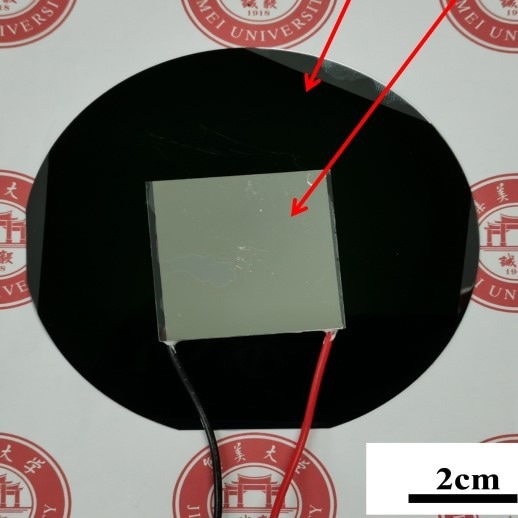Researchers have created a novel thermoelectric generator (TEG) that uses heat from the sun and a radiative element that radiates heat into the air to continuously generate power. The new self-powered TEG could offer a reliable power supply for small electronic devices like outdoor sensors as it is capable of operating day or night and in overcast weather.

The new self-powered thermoelectric generator device uses an ultra-broadband solar absorber (UBSA) to capture sunlight, which heats the generator. Simultaneously, another component called a planar radiative cooling emitter (RCE) cools part of the device by releasing heat. Image Credit: Haoyuan Cai, Jimei University
Traditional power sources like batteries are limited in capacity and require regular replacement or recharging, which can be inconvenient and unsustainable. Our new TEG design could offer a sustainable and continuous energy solution for small devices, addressing the constraints of traditional power sources like batteries.
Jing Liu, Research Team Leader, Jimei University
TEGs are solid-state devices devoid of moving parts and instead use temperature differences to create power.
In the Optica Publishing Group journal Optics Express, Liu and a multi-institutional team of researchers describe and demonstrate a new TEG that can simultaneously generate the heat and cold necessary to create a temperature difference significant enough to generate electricity even when the sun is not shining.
The passive power source is made of components that can easily be manufactured.
Liu added, “The unique design of our self-powered thermoelectric generator allows it to work continuously, no matter the weather. With further development, our TEG has the potential to impact a wide range of applications, from remote sensors to wearable electronics, promoting a more sustainable and eco-friendly approach to powering our daily lives.”
Boosting TEG Performance
A temperature gradient will cause electrons in a thermoelectric material to move from the hot to the cold portion, producing an electric current. Although there are TEGs based on this phenomenon, they frequently result in unstable temperature differences and fail to generate sufficient electricity to be of any value.
The researchers created a new type of TEG to help overcome these drawbacks. One side of the generator is heated by sunlight that is collected by a component known as an ultra-broadband solar absorber (UBSA).
Another component, known as a planar radiative cooling emitter (RCE), cools the opposite side simultaneously by releasing heat. Both the UBSA and RCE can be applied to a flexible substrate, which could be useful for powering wearable devices.
The researchers positioned the RCE on top of a UBSA with a larger area because, under normal sunlight intensity, the UBSA’s heating power is much greater than the RCE’s cooling power.
When the entire device is exposed to sunlight, the unshaded parts of UBSA absorb the sun’s energy to heat up while the RCE on top begins to cool. A temperature difference is produced by heating and cooling that is then transformed into electricity.
On cloudy days or at night, the temperature difference is significantly lower as there is a lack of direct sunlight. However, there is still some temperature difference that can be utilized to generate electricity, albeit at a lower efficiency compared to a sunny day.
Generating Power at Night
The researchers performed trials outside, in various weather types, to test the device. They kept an eye on the device’s voltage output and discovered that it could continue producing electricity throughout the day, at night, and even in cloudy daylight hours.
During the clear daytime, the device produced a peak voltage output of 166.2 mV, sufficient to power a small sensor or device. It generated 14.7 mV and 95 mV, respectively, in clear daylight and clear nighttime conditions.
Our innovative method for combining solar heating with radiative cooling allows the TEG to generate electricity that is uninterrupted. This could improve access to critical services, particularly in remote or underdeveloped areas where traditional power sources are not available.
Haoyuan Cai, Research Team Member, Jimei University
Researchers are further optimizing the device’s efficiency, robustness, and scalability. They also intend to test the device’s long-term reliability and stability under multiple scenarios.
Additionally, they seek to enhance the functionality of the device and its adaptability to various applications while looking into the possibility of mass production at an affordable price.
Journal Reference:
Liu, J., et al. (2023) All-day uninterrupted thermoelectric generator by simultaneous harvesting of solar heating and radiative cooling. Optics Express. doi:10.1364/OE.483531.